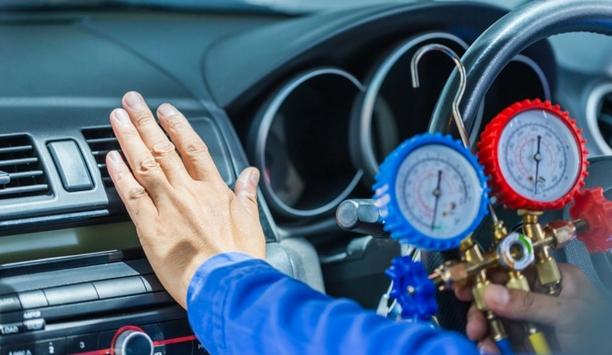Devastating wildfires sweep across the US each year, leaving a trail of destruction in their wake. Aside from the immediate damage that fire causes to property and land, the additional impact that wildfire smoke has on air quality creates a serious but often overlooked threat to human health.
This threat from poor air quality includes people in the workplace.
IAQ management
As wildfires increase in frequency and intensity, facility managers must be proactive to protect occupants inside their buildings.
This article will explore how facility managers can manage indoor air quality during wildfires, focusing on the role and importance of HVAC systems and continuous IAQ monitoring.
Huge Economic Losses to Business and Property
The effects of wildfire smoke on air quality also have far-reaching consequences for businesses
Wildfires cause massive destruction, with US workers suffering an annual average loss of $125 billion in pay. The broader economic impact is estimated to cost the US between $394 and $893 billion annually.
While some of these costs result from direct fire and smoke damage, the effects of wildfire smoke on air quality also have far-reaching consequences for businesses regarding the “knock-on” effects, such as sick days caused by respiratory issues, productivity, and general well-being. Managing indoor air quality to keep building occupants safe, such as office workers, school students, and staff, is therefore becoming an essential part of a facility manager’s job.
The Health Risks from Exposure to Wildfire Smoke
- The Invisible Invaders: Wildfire smoke carries a range of harmful pollutants, including fine particulate matter (PM2.5) and volatile organic compounds (VOCs). These microscopic particles can penetrate the lungs, causing respiratory and cardiovascular problems. As Professor Jeffery Siegel explained in a recent webinar hosted by Airthings, wildfire smoke also contains volatile and semi-volatile compounds and inorganic gas-phase compounds, many of which can pose significant health risks to people, such as eye, nose, and throat irritation, and, in more serious cases, cancers, immune suppressions, reproductive problems, and dementia
- Beyond the Obvious: The effects of wildfire smoke extend beyond the immediate vicinity of the fire. Smoke can travel hundreds of miles, infiltrating buildings and compromising indoor air quality even in distant areas.
- The Silent Threat: While staying indoors may seem like a haven, wildfire smoke can easily seep into buildings through windows, doors, and ventilation systems. Without proper IAQ management, the air inside can become as hazardous as the outside air.
HVAC Systems: an Essential First Line of Defense
Facility and building managers have challenging roles at the best of times
When an area is affected by wildfire smoke, properly functioning HVAC systems and their filters, alongside strategies such as automating BMS to close dampers or increase ventilation when PM2.5 levels rise above a certain level, become critical for keeping people inside a building safe.
Facility and building managers have challenging roles at the best of times, so how can optimizing HVAC systems support them in keeping building occupants safe during the difficulties posed by wildfires?
Continuous IAQ Monitoring: The Key to Informed Action
Preparing a building to cope with the risks posed by wildfire smoke is virtually impossible without knowing the baseline of what’s “normal” for your building’s HVAC performance, alongside demonstrating how a building might have performed during a previous wildfire and whether past mitigation strategies worked.
Case Study:
A customer we spoke to recently realized that their building’s reception area was particularly affected by dangerous levels of PM2.5 during a wildfire due to the simple fact that the outside door was regularly opening and closing. This insight led to targeted interventions, such as installing an air curtain, to improve IAQ in that area.
However, IAQ data from deeper inside the building determined that PM2.5 levels were safe, showing that the HVAC system and plan for sealing the building were working. Had PM2.5 levels been high across the building, this would indicate that the HVAC systems were not performing as they should. The customer now knows that their strategy works and can rely on it in the future.
IAQ Monitoring: Beyond Pollutant Detection
- System Performance: IAQ monitors can help assess the effectiveness of HVAC filtration and ventilation systems. By tracking changes in pollutant levels, facility managers can identify areas where additional measures, such as localized air purifiers, may be needed.
- Occupancy Patterns: Some IAQ monitors also measure occupancy, providing valuable information about which areas of the building are most frequently used. This data can guide ventilation strategies and optimize air quality in occupied spaces.
Top Tips for Facility Managers
Keeping People Safe During a Wildfire
As discussed, facility managers are integral to maintaining safe indoor air during a wildfire. The following are some tips for how facility managers can help keep people safe inside a building during a wildfire:
- Install Air Quality Monitors: Use IAQ devices that continuously measure PM, VOCs, and CO2. These devices provide real-time and historical data to inform decisions about ventilation and filtration. Understanding indoor air quality conditions allows facility managers to respond promptly to any changes, ensuring that air quality remains within safe limits.
- Proactively Maintain HVAC Systems: Upgrade or Replace Filters: Use high-efficiency filters, such as HEPA filters, that can capture fine particles and replace them regularly to maintain their effectiveness. Filters should be checked frequently during wildfire season, as they can become clogged with smoke particles more quickly than usual, reducing their effectiveness. Regular maintenance of HVAC systems is crucial to ensure they operate efficiently.
- Seal Buildings: Ensure that doors, windows, and other openings are properly sealed to prevent outdoor pollutants from entering. Use weather stripping and caulking to seal gaps around doors and windows, and consider installing air curtains in entryways to stop smoke from seeping deeper into a building.
- Limit Outdoor Air Intake: Adjust HVAC systems to minimize outdoor air intake when smoke levels are high. While fresh air is generally beneficial, it can introduce harmful pollutants into indoor spaces during wildfires. Use recirculation settings in HVAC systems to keep indoor air moving without drawing in contaminated outside air. However, if outdoor air intake is still necessary, ensure that high-efficiency filters that control PM and gaseous chemicals are fitted.
- Communicate Risks and Actions: Educate building occupants about air quality risks. Clear communication helps alleviate concerns and ensures everyone understands the importance of maintaining IAQ. Provide regular updates on air quality conditions and any changes to building operations. Encourage occupants to participate in IAQ efforts, such as keeping windows closed and reporting any issues with air quality.
Conclusion
Monitoring IAQ and Proactive Maintenance Key for Protecting People During Wildfires
To conclude, ensuring that the air inside a building is safe during a wildfire is essential for protecting people and productivity.
An approach that includes proactive HVAC maintenance, continuous IAQ monitoring, and also general preparedness regarding the necessary steps to take during a wildfire is crucial for keeping the people inside a building safe even when the air outside might be compromised.



















